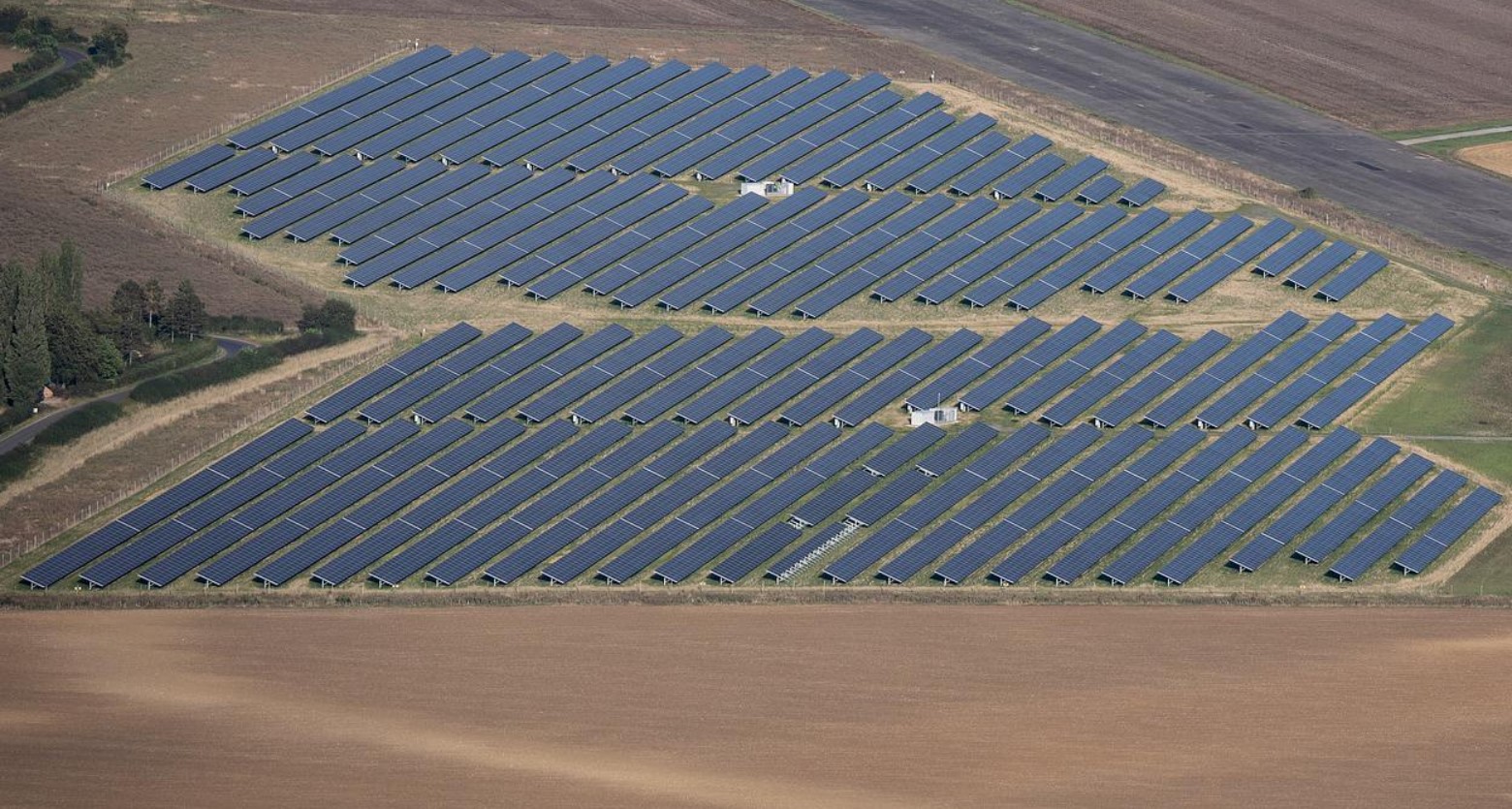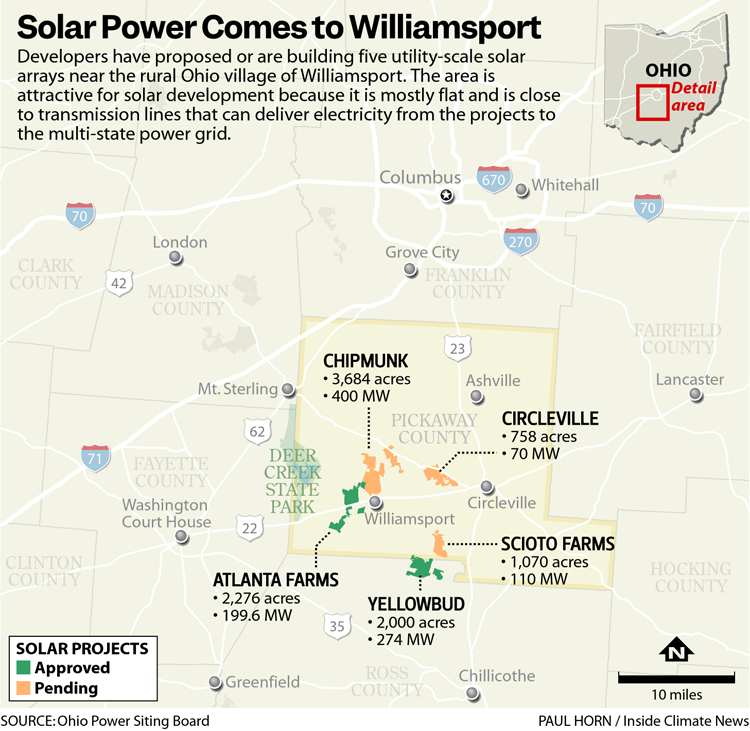 By B.N. Frank
By B.N. Frank
A growing number of Americans are trying to keep solar farms from being built in their communities for numerous reasons (see 1, 2, 3). This includes residents of Williamsport, Ohio.
From Inside Climate News:
The Energy Transition Runs Into a Ditch in Rural Ohio
Resistance to renewable energy is growing in America’s farm country, including in this Ohio village where a solar proposal has divided the community. Here’s how it looks to two families that used to be friends: the Scheins and the Barneses.
By Dan Gearino
This story is the first in a series about the conflict over solar power in Williamsport, Ohio, reported in partnership with ABC News.
WILLIAMSPORT, Ohio—Mark Schein sings from the back row, aware that many of the people in the other pews view him as their enemy.
His wife, Toni, stands by his side, but the rows around them are all empty.
The hymn at this May service, backed by a pipe organ, is “Guide Me, O Thou Great Jehovah,” about perseverance in the face of great challenges.
Mark is a retired farmer, a parent, a grandparent and part of a family that has attended this church, Williamsport United Methodist, since its construction in 1900. His offense in the eyes of many in this community is that he signed a lease with a developer that wants to build a solar array, one of five solar projects in the area that opponents say will drive down property values and turn a pastoral landscape into a toxic industrial site.
“I don’t have very many neighbors talk to me anymore,” he said.
Solar power is an essential part of dealing with the threat of climate change, but this proposal has inspired intense opposition from people who view solar as a threat to their idea of home. Instead of cheering a boost to the tax base and to farmers’ incomes, the critics see an invader that will make the place they love unrecognizable, and they see supporters of solar, even if they are friends and neighbors, as adversaries.
The solar opponents include the Barnes family, who are seated together on the opposite side in some of the only pews that are close to full. It was a Barnes who printed and helped to distribute hundreds of signs that say, “No Industrial Solar Plants on Farmland.”
“They’ve been putting up road signs, and articles in the paper, you know, just like we were the devils of the earth,” Mark said.
The Scheins and the Barneses don’t speak much anymore, but they can’t avoid crossing paths on a regular basis.
The divisions in Williamsport are important not because they are unusual but because they are common. Rural communities are increasingly rising up to oppose renewable energy, as shown in a 2021 study by researchers at Michigan State University and the University of Michigan. Also, a team at MIT wrote this year about 53 renewable energy projects across the country that were delayed or blocked, finding that many of the same objections arise over and over, about aesthetics, safety and property values.
Among the other examples: In Indiana, more than a dozen counties have passed rules to stop construction of new wind farms because of concerns about overdevelopment and health issues; in Nevada, residents are campaigning against solar projects in the desert just west of Las Vegas, citing the potential damage to native plants and animals; and Virginia has become an epicenter of opposition to solar power, with high-profile fights like one against a project in Spotsylvania.
The conflict is one of many urban-rural divides, in which rural areas dominated by Republicans are being asked to transform their landscapes to make electricity that will mainly serve cities dominated by Democrats.
The opposition often begins with a gut-level fear that solar or wind power is going to harm the look and feel of home, and then gets supercharged as people read and repeat talking points popularized by Donald Trump and others about how renewable energy is unreliable and dangerous. This is not to say that all the opponents are Republicans and that all the talking points are incorrect, only that there is a partisan sheen and a dearth of fact-checking.
And the tone of the debate often reflects the way Trump has changed what’s acceptable public discourse, with attacks that are more personal.
If nearly every renewable energy proposal turns into a political and legal quagmire, then there is little hope that the United States can make the energy transition needed to address climate change.
Viewed as a Villain
Mark signed his lease three years ago, when the developer was putting together the land to propose the project. The lease payments would be five times what he earns from renting out the land to someone to farm it. He saw the income as a way to provide for his family for decades, even after he is gone.
Late last fall, he began to sense that a switch had flipped in the community, soon after the developer began to apply for a state permit. For the first time, people knew how large the project was going to be—about 2,700 football fields—and that it was going to be visible from dozens of houses occupied by people who had not leased their land.
The Barneses and several other prominent farm families chose not to lease their land because of concerns that the panels would change the look and feel of the place, and a reluctance to remove land from crop production. They organized an opposition campaign. Next came the anti-solar signs and a Facebook page for the local opposition group.
For Mark, it felt strange for others to say that this shift in the landscape was too much, because he had watched a lifetime of change. He grew up at a time when just about every farm was small and most farm families were large. He saw how a few people bought out the others to put together megafarms.
When so many others left over the decades, he had stayed on his relatively small 250 acres and in the house built by his great-great-grandfather in the 1870s. And now he was the villian. To hear the opponents say it, the people who signed leases were either greedy for supporting a harmful project, or stupid for not realizing the harm.
In regard to solar panels in general, research has indicated that they are they are currently not eco-friendly or cost effective and they create and emit harmful electromagnetic radiation. Tesla solar panels have also been catching fire (see 1, 2, 3). High costs associated with California’s solar mandates has made solar less popular there too.
Recently, however, it was reported that progress is being made to reuse material from old solar panels instead of just dumping the panels into landfills. So that’s good news for anyone concerned about that.
Activist Post reports regularly about solar energy and unsafe technology. For more information, visit our archives.
Image: Pixabay
Become a Patron!
Or support us at SubscribeStar
Donate cryptocurrency HERE
Subscribe to Activist Post for truth, peace, and freedom news. Follow us on SoMee, Telegram, HIVE, Flote, Minds, MeWe, Twitter, Gab, What Really Happened and GETTR.
Provide, Protect and Profit from what’s coming! Get a free issue of Counter Markets today.


Be the first to comment on "Solar Project Divides Community; “I don’t have very many neighbors talk to me anymore”"